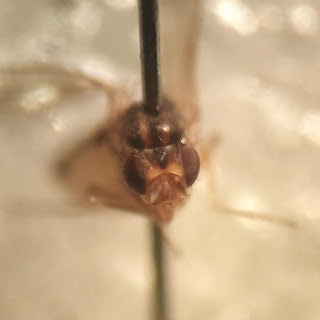Had a nice trip across the water to Lundy earlier this week. Splashed out on a copy of 'Lundy Fungi' by John Hedger & David George (published by The Lundy Field Society) which turned out to be money well spent as it's a really nice, informative photographic guide to the species you're likely to encounter in the island's different habitats.
Much of Lundy is designated as a SSSI and, as I was just there as a day-tripper, I'd made no effort to obtain the necessary permissions to collect specimens for identification purposes. What follows is therefore an account of what I was able to observe of the island's fungi in situ.
I'm reasonably certain the mushrooms in the photo above are Fairy Ring Champignon Marasmius oreades, with that pronounced umbo. They were growing in the short grass on the cliff-top, near Devil's Slide.
The grazed areas we passed through on our walk up the western coast were dotted with piles of dung, hosting some impressive fungal displays.
I think these pair are Egghead Mottlegill Panaeolus semiovatus...
The stems were dusted with black spores...
... and this younger specimen shows the ring around the stem nicely.
These, I'm sure, are something different. But I would not be confident in naming them.
I noticed that the young fruit body emerging towards the centre of this photograph had a distinctive reddish-brown colour to it.
UPDATE 20/06/2019 - advice from Mandy Dee, Lundy Fungus Recorder, over on the British Mycological Society Facebook page, is that this is Psilocybe coprophila.
I suspect this yellow fellow is something different again. But hard to say without a closer look.
UPDATE 20/06/2019 - advice from Mandy Dee is that this is Stropharia semiglobata. A species which the Lundy Fungi book describes as very common on Lundy.
On the heath, near Jenny's Cove, I spotted quite a few of these guys. I think they're Heath Navel Lichenomphalia umbellifera.
And the Golden Hair Lichen Teloschistes flavicans at the North End was pretty special.
Heading back towards civilisation, on Hangman's Hill, I was happy to come across Campion Anther Smut Microbotryum lychnidis-dioicae again (after my recent encounter close to home).
And there was the ubiquitous bramble rust...
With reference to Ellis & Ellis's 'Microfungi on Land Plants', I think my collection is Phragmidium violaceum, with its mostly 3-septate teliospores. A new one for me.
For the record
Date: 18/06/2019
Location: Lundy, Devon


























